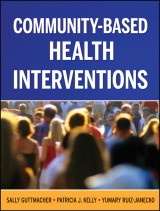Details
Community-Based Health Interventions
3. Aufl.
|
64,99 € |
|
| Verlag: | Wiley |
| Format: | EPUB |
| Veröffentl.: | 02.02.2010 |
| ISBN/EAN: | 9780470575086 |
| Sprache: | englisch |
| Anzahl Seiten: | 240 |
DRM-geschütztes eBook, Sie benötigen z.B. Adobe Digital Editions und eine Adobe ID zum Lesen.
Beschreibungen
Community-Based Health Interventions covers the skills necessary to change health in a community setting through the reduction of disease, disease conditions, and risks to health, as well as create a supportive environment for the maintenance of the behavior changes. The first section provides background information about why interventions in communities are important, the history of several major community interventions, ethical issues in the design and implementation of interventions and the different types of interventions. The second section covers planning and activities needed to complete an intervention, along with the theoretical basis of interventions. The third section shows how to assess the needs and strengths of a particular community, gain community support, define the goals of an intervention and get started. This section also contains information on obtaining material and financial support and on strategies for continuing the intervention beyond its initial phase. The final section examines current work and problems encountered as well as projecting future trends. Each chapter includes practice exercises or activities useful to students learning to develop interventions at the population or community level, such as public health, social work and nursing.
<p>Tables, Figure, and Exhibit ix</p> <p>Preface xi</p> <p>Acknowledgments xiii</p> <p>The Authors xv</p> <p><b>PART ONE introducing community-based interventions 1</b></p> <p><b>1 IMPROVING HEALTH IN COMMUNITY SETTINGS 3</b></p> <p>Defining Community 4</p> <p>Ecological Theory and Levels of Prevention 5</p> <p><b>2 A BRIEF HISTORY OF COMMUNITY-BASED HEALTH INTERVENTIONS 11</b><br /><i>Diana Silver <br /><br /></i>Community-Based Health Interventions: An Instrument for Change 12</p> <p>Early Community-Based Health Interventions 15</p> <p>Assessing the Evidence from Early Community-Based Health Interventions 18</p> <p>The Evolution of Community-Based Health Interventions 19</p> <p><b>3 ETHICAL ISSUES IN COMMUNITY INTERVENTIONS 25</b></p> <p>The Integration of Ethics into Public Health Practice 26</p> <p>Institutional Review Boards 28</p> <p>Vulnerable Populations 29</p> <p>Permission and Consent 30</p> <p>Protection for Research Participants 33</p> <p>Ensuring Research Quality 34</p> <p>Maintaining the Integrity of Research 35</p> <p><b>4 LEVELS AND TYPES OF COMMUNITY-Based INTERVENTIONS 39</b></p> <p>An Ecological Focus on Types of Prevention 40</p> <p>Selecting a Goal for the Intervention 42</p> <p>Examples of Interventions at Different Levels of Prevention 45</p> <p><b>PART TWO developing the intervention 51</b></p> <p><b>5 A FRAMEWORK FOR DESIGNING COMMUNITY-Based INTERVENTIONs 53</b></p> <p>Theoretical Guidance for Health Interventions 54</p> <p>Examples of Theories Used at the Four Ecological Levels 56</p> <p><b>6 COLLECTING AND MANAGING DATA 65</b></p> <p>Data: A Crucial Component of Research 66</p> <p>Collecting Quantitative Data 67</p> <p>Collecting Qualitative Data 73</p> <p>After Data Collection 75</p> <p><b>PART THREE working through the intervention 81</b></p> <p><b>7 ASSESSING COMMUNITY NEEDS 83</b></p> <p>Basic Components of a Community Assessment 84</p> <p>Strengthening Your Findings 87</p> <p><b>8 PLANNING A COMMUNITY-BASED INTERVENTION 95</b></p> <p>Intervention Content and Format 96</p> <p>A Logic Model as an Organizing Strategy 101</p> <p>A Fictional Community Assessment: Adolescent Tobacco Use 104</p> <p><b>9 IMPLEMENTING A COMMUNITY-BASED INTERVENTION 115</b></p> <p>Implementation at the Four Ecological Levels 116</p> <p>Interventions at the Community or Policy Level 123</p> <p><b>10 EVALUATING A COMMUNITY-BASED INTERVENTION 127</b></p> <p>Reasons for Evaluation 128</p> <p>Preparing for an Evaluation 130</p> <p>Designing the Evaluation 130</p> <p>Flexibility: An Essential Skill in Evaluation 135</p> <p><b>PART FOUR learning from the past and adapting to the future 137</b></p> <p><b>11 FUNDING AND SUSTAINABILITY 139</b></p> <p>Financing Community-Based Health Interventions 140</p> <p>Components of the Proposal for Funding 143</p> <p>Components of the Budget 150</p> <p>Continuing and Sustaining an Intervention 155</p> <p><b>12 IMPLEMENTATION PITFALLS 157</b></p> <p>Things Happen 158</p> <p><b>13 THE FUTURE OF COMMUNITY-BASED HEALTH INTERVENTIONS 165</b></p> <p>Adapting Methods of Intervention to Twenty-First–Century Communities 166</p> <p>A Challenge and an Opportunity for Public Health Practitioners 169</p> <p>A Limitation of the New Technologies 173</p> <p><b>14 COMMUNITY-BASED HEALTH INTERVENTIONS IN PRACTICE 177</b></p> <p>Arthritis 178</p> <p>Asthma 179</p> <p>Adult Vaccinations 181</p> <p>Alcohol Use 182</p> <p>Cardiovascular Disease 183</p> <p>Childhood Vaccinations 184</p> <p>Injuries from Motor Vehicle Accidents 185</p> <p>Sexual Assault and Relationship Violence 186</p> <p>Smoking 187</p> <p>Glossary 191</p> <p>References 203</p> <p>Index 211</p>
<p>Sally Guttmacher, PhD, is professor of Public Health in the Department of Nutrition, Food Studies and Public Health at New York University. Patricia J. Kelly, PhD, MPH, APRN, is professor at the University of Missouri, School of Nursing. Yumary Ruiz-Janecko, PhD, is a clinical assistant professor of Public Health at New York University. </p>
Community-Based Health Interventions covers the skills necessary to change health in a community setting through the reduction of disease, disease conditions, and risks to health, as well as create a supportive environment for the maintenance of the behavior changes. The first section provides background information about why interventions in communities are important, the history of several major community interventions, ethical issues in the design and implementation of interventions and the different types of interventions. The second section covers planning and activities needed to complete an intervention, along with the theoretical basis of interventions. The third section shows how to assess the needs and strengths of a particular community, gain community support, define the goals of an intervention and get started. This section also contains information on obtaining material and financial support and on strategies for continuing the intervention beyond its initial phase. The final section examines current work and problems encountered as well as projecting future trends. Each chapter includes practice exercises or activities useful to students learning to develop interventions at the population or community level, such as public health, social work and nursing.



















